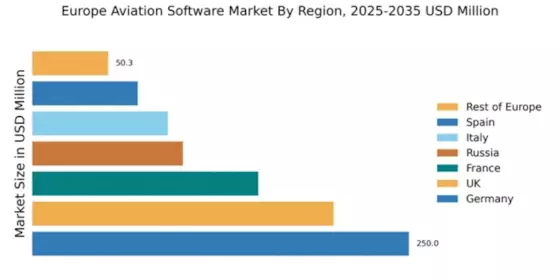Growing Demand for Operational Efficiency
Operational efficiency remains a critical driver in the aviation software market in Europe. Airlines and operators are increasingly seeking software solutions that optimize flight operations, reduce turnaround times, and enhance fuel management. The implementation of advanced analytics and data-driven decision-making tools is becoming commonplace, as these technologies can lead to substantial cost savings. For instance, airlines that adopt integrated software solutions report reductions in operational costs by up to 15%. This trend is likely to continue, as the competitive landscape compels operators to leverage technology for improved efficiency. Consequently, the aviation software market is expected to witness robust growth, driven by the pursuit of operational excellence and cost-effectiveness.
Regulatory Compliance and Safety Standards
The aviation software market in Europe is heavily influenced by stringent regulatory compliance and safety standards. The European Union Aviation Safety Agency (EASA) mandates rigorous adherence to safety protocols, which necessitates the integration of advanced software solutions. This compliance drives demand for software that can ensure operational safety, manage maintenance schedules, and facilitate real-time monitoring of aircraft systems. As a result, the market is projected to grow at a CAGR of approximately 7% over the next five years, reflecting the increasing need for compliance-driven software solutions. Furthermore, the emphasis on safety and regulatory adherence fosters innovation within the aviation software market, as companies strive to develop cutting-edge technologies that meet or exceed these standards.
Rise of Digital Transformation Initiatives
Digital transformation is a key driver reshaping the aviation software market in Europe. As the industry embraces technological advancements, there is a growing emphasis on digitizing operations, enhancing customer experiences, and streamlining processes. Airlines are investing in software solutions that facilitate seamless communication, improve passenger engagement, and automate various operational tasks. This shift towards digitalization is expected to propel the aviation software market forward, with projections indicating a growth rate of around 7% annually. The ongoing digital transformation initiatives are likely to redefine operational paradigms, fostering innovation and efficiency within the sector.
Emergence of Sustainable Aviation Initiatives
Sustainability is emerging as a pivotal driver in the aviation software market in Europe. With increasing pressure to reduce carbon emissions and enhance environmental stewardship, airlines are turning to software solutions that support sustainable practices. This includes tools for optimizing flight paths, managing fuel consumption, and tracking emissions. The European Commission has set ambitious targets for reducing aviation emissions, which could lead to a market shift towards software that facilitates compliance with these sustainability goals. As a result, the aviation software market is likely to expand, with a projected growth rate of around 6% annually, as stakeholders prioritize eco-friendly solutions.
Advancements in Data Analytics and Business Intelligence
The aviation software market in Europe is experiencing a surge in demand for data analytics and business intelligence tools. Airlines and operators are increasingly recognizing the value of data-driven insights for enhancing decision-making processes. Advanced analytics can provide critical information on passenger behavior, operational performance, and market trends, enabling companies to make informed strategic choices. The integration of these tools into existing software platforms is becoming essential for maintaining a competitive edge. As a result, the aviation software market is anticipated to grow, with estimates suggesting an increase of approximately 8% in the adoption of analytics-driven solutions over the next few years.


















Leave a Comment